Study on the Pollution Characteristics and Sources of Ozone in Typical Loess Plateau City
Abstract
:1. Introduction
2. Data and Methods
3. Results and Discussion
3.1. The O3 Pollution in Taiyuan in 2018
3.1.1. O3 Concentrations Standard and Variation of O3 Concentrations
3.1.2. Diurnal Variation of O3 Concentration
3.1.3. Variation of MDA8 at Each Monitoring Site and Their Contributions to the Average of MDA8 in Taiyuan
3.2. Study on the Causes of O3 Pollution in Taiyuan
3.2.1. Temperature
3.2.2. Air Pressure
3.2.3. Topography
3.2.4. Wind Direction and Regional Transport
3.3. Countermeasures and Suggestions for Control of O3 Pollution in Taiyuan
4. Conclusions
Author Contributions
Funding
Acknowledgments
Conflicts of Interest
References
- Castro, T.; Madronich, S.; Rivale, S.; Muhlia, A.; Mar, B. The influence of aerosols on photochemical smog in Mexico City. Atmos. Environ. 2001, 35, 1765–1772. [Google Scholar] [CrossRef]
- Kanda, I.; Wakamatsu, S. Small-scale variations in ozone concentration in low mountains. Atmos. Environ. 2018, 184, 98–109. [Google Scholar] [CrossRef]
- Quan, J.; Dou, Y.; Zhao, X.; Liu, Q.; Sun, Z.; Pan, Y.; Jia, X.; Cheng, Z.; Ma, P.; Su, J.; et al. Regional atmospheric pollutant transport mechanisms over the North China Plain driven by topography and planetary boundary layer processes. Atmos. Environ. 2020, 221. [Google Scholar] [CrossRef]
- Toh, Y.Y.; Lim, S.F.; Von Glasow, R. The influence of meteorological factors and biomass burning on surface ozone concentrations at Tanah Rata, Malaysia. Atmos. Environ. 2013, 70, 435–446. [Google Scholar] [CrossRef]
- Wang, X.; Lu, W.; Wang, W.; Leung, A.Y. A study of ozone variation trend within area of affecting human health in Hong Kong. Chemosphere 2003, 52, 1405–1410. [Google Scholar] [CrossRef]
- Musselman, R.C.; Minnick, T.J. Nocturnal stomatal conductance and ambient air quality standards for ozone. Atmos. Environ. 2000, 34, 719–733. [Google Scholar] [CrossRef]
- Ma, Z.; Xu, J.; Quan, W.; Zhang, Z.; Lin, W.; Xu, X. Significant increase of surface ozone at a rural site, north of eastern China. Atmos. Chem. Phys. 2016, 16, 3969–3977. [Google Scholar] [CrossRef] [Green Version]
- Wang, T.; Xue, L.; Brimblecombe, P.; Lam, Y.F.; Li, L.; Zhang, L. Ozone pollution in China: A review of concentrations, meteorological influences, chemical precursors, and effects. Sci. Total Environ. 2017, 575, 1582–1596. [Google Scholar] [CrossRef]
- Ministry of Ecology and Environment of the People’s Republic of China. Ambient Air Quality Standards; Ministry of Ecology and Environment of the People’s Republic of China: Beijing, China, 1996; Volume 3095, p. 12. [Google Scholar]
- Zhang, J.; Wang, C.; Qu, K.; Ding, J.; Shang, Y.; Liu, H.; Wei, M. Characteristics of ozone pollution, regional distribution and causes during 2014–2018 in Shandong Province, East China. Atmosphere 2019, 10, 501. [Google Scholar] [CrossRef] [Green Version]
- Yusoff, M.F.; Latif, M.T.; Juneng, L.; Khan, F.; Ahamad, F.; Chung, J.X.; Mohtar, A.A.A. Spatio-temporal assessment of nocturnal surface ozone in Malaysia. Atmos. Environ. 2019, 207, 105–116. [Google Scholar] [CrossRef]
- Li, Q.; Gabay, M.; Rubin, Y.; Ravehrubin, S.; Rohatyn, S.; Tatarinov, F.; Rotenberg, E.; Ramati, E.; Dicken, U.; Preisler, Y. Investigation of ozone deposition to vegetation under warm and dry conditions near the Eastern Mediterranean coast. Sci. Total Environ. 2019, 658, 1316–1333. [Google Scholar] [CrossRef]
- Brönnimann, S.; Neu, U. Weekend-weekday differences of near-surface ozone concentrations in Switzerland for different meteorological conditions. Atmos. Environ. 1997, 31, 1127–1135. [Google Scholar] [CrossRef]
- Geng, F.; Tie, X.; Xu, J.; Zhou, G.; Peng, L.; Gao, W.; Tang, X.; Zhao, C. Characterizations of ozone, NOx, and VOCs measured in Shanghai, China. Atmos. Environ. 2008, 42, 6873–6883. [Google Scholar] [CrossRef]
- Wang, H.; Ling, C.; Chen, X.; Yu, Y.; Bai, L. Effects of weather conditions on the distribution of near-surface ozone in Fuzhou. J. Ecol. Environ. 2011, 20, 1320–1325. [Google Scholar]
- Bao, J.W.; Michelson, S.A.; Persson, P.; Djalalova, I.; Wilczak, J. Observed and WRF-simulated low-level winds in a high-ozone episode during the Central California Ozone Study. J. Appl. Meteorol. Climatol. 2008, 47, 2372–2394. [Google Scholar] [CrossRef]
- Beaver, S.; Palazoglu, A. Influence of synoptic and mesoscale meteorology on ozone pollution potential for San Joaquin Valley of California. Atmos. Environ. 2009, 43, 1779–1788. [Google Scholar] [CrossRef]
- Serafin, S.; Zardi, D. Daytime heat transfer processes related to slope flows and turbulent convection in an idealized mountain valley. J. Atmos. Sci. 2010, 67, 3739–3756. [Google Scholar] [CrossRef] [Green Version]
- Fu, B. Valley wind. Meteorol. Sci. 1980, Z1, 1–14. [Google Scholar]
- Kitada, T.; Igarashi, K.; Owada, M. Numerical analysis of air pollution in a combined field of land/sea breeze and mountain/valley wind. J. Clim. Appl. Meteorol. 1986, 25, 767–784. [Google Scholar] [CrossRef] [Green Version]
- Wang, N.; Guo, H.; Jiang, F.; Ling, Z.H.; Wang, T. Simulation of ozone formation at different elevations in mountainous area of Hong Kong using WRF-CMAQ model. Sci Total Environ. 2015, 505, 939–951. [Google Scholar] [CrossRef]
- Pun, B.K.; Seigneur, C.; White, W. Day-of-week behavior of atmospheric ozone in three US cities. J. Air Waste Manag. Assoc. 2003, 53, 789–801. [Google Scholar] [CrossRef] [PubMed]
- Ren, Y.; Ding, A.; Wang, T.; Shen, X.; Guo, J.; Zhang, J.; Wang, Y.; Xu, P.; Wang, X.; Gao, J. Measurement of gas-phase total peroxides at the summit of Mount Tai in China. Atmos. Environ. 2009, 43, 1702–1711. [Google Scholar] [CrossRef]
- Camalier, L.; Cox, W.M.; Dolwick, P. The effects of meteorology on ozone in urban areas and their use in assessing ozone trends. Atmos. Environ. 2007, 41, 7127–7137. [Google Scholar] [CrossRef]
- Vasconcelos, L.A.d.P. Spatial resolution of a transport inversion technique. J. Geophys. Res. 1996, 101, 337–342. [Google Scholar] [CrossRef]
- Seibert, P.; Kromp-Kolb, H.; Baltensperger, U.; Jost, D.T.; Schwikowski, M. Trajectory analysis of high-alpine air pollution data. In Air Pollution Modeling and Its Application X; Gryning, S.-E., Millán, M.M., Eds.; Springer: Boston, MA, USA, 1994; pp. 595–596. [Google Scholar]
- Hsu, Y.-K.; Holsen, T.M.; Hopke, P.K. Comparison of hybrid receptor models to locate PCB sources in Chicago. Atmos. Environ. 2003, 37, 545–562. [Google Scholar] [CrossRef]
- Hao, T.; Cai, Z.; Chen, S.; Han, S.; Yao, Q.; Fan, W. Transport pathways and potential source regions of PM2.5 on the West Coast of Bohai Bay during 2009–2018. Atmosphere 2019, 10, 345. [Google Scholar] [CrossRef] [Green Version]


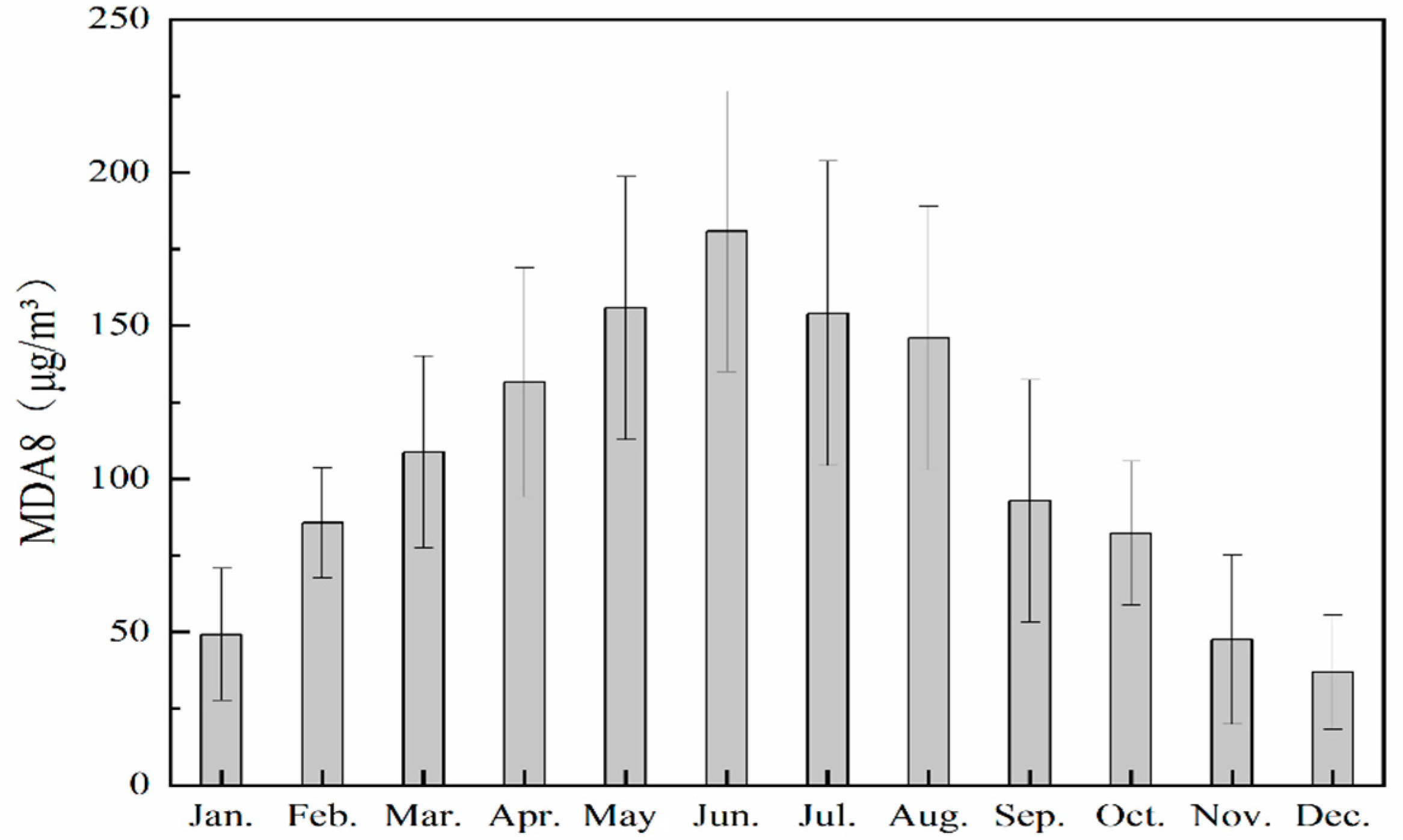
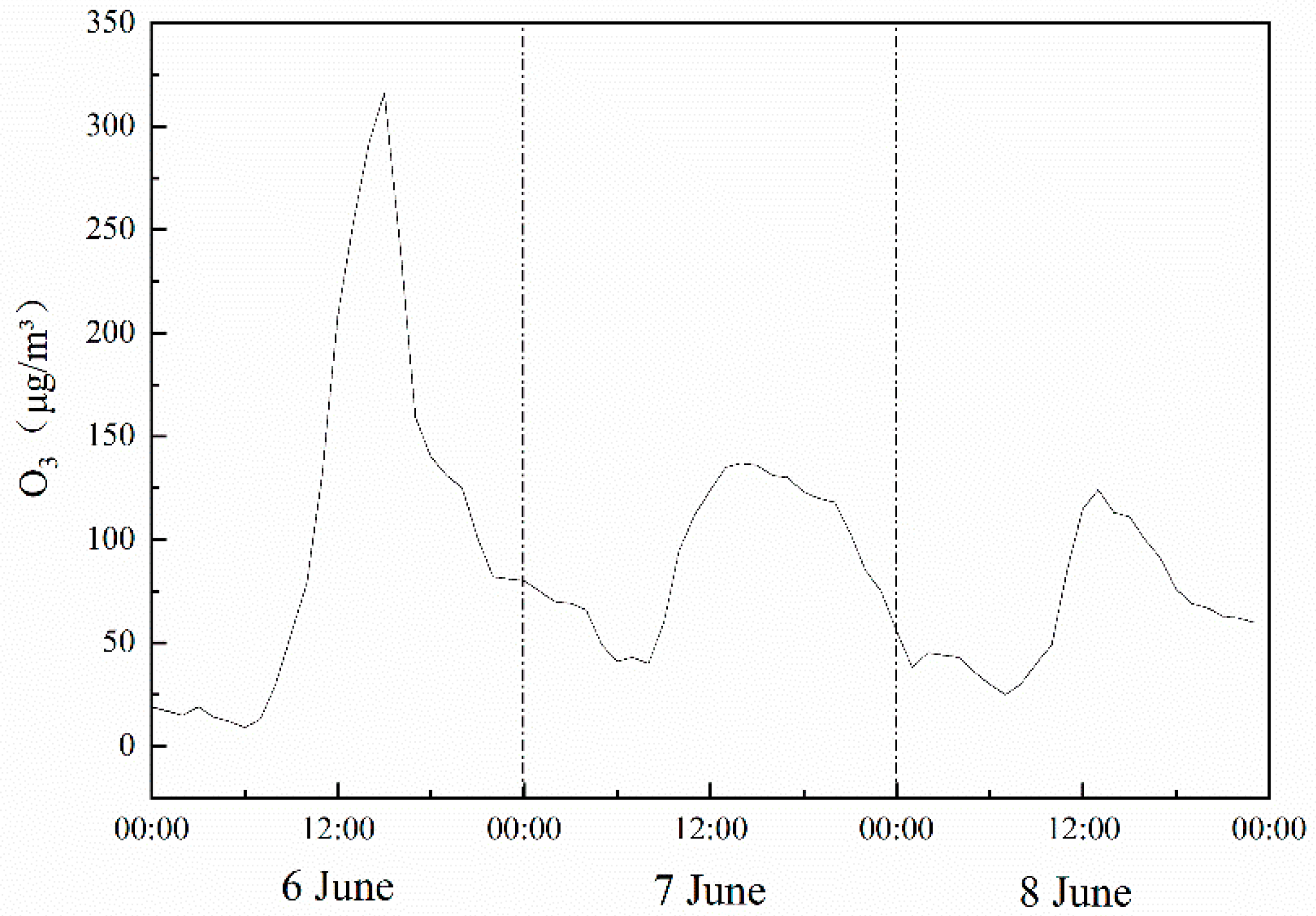
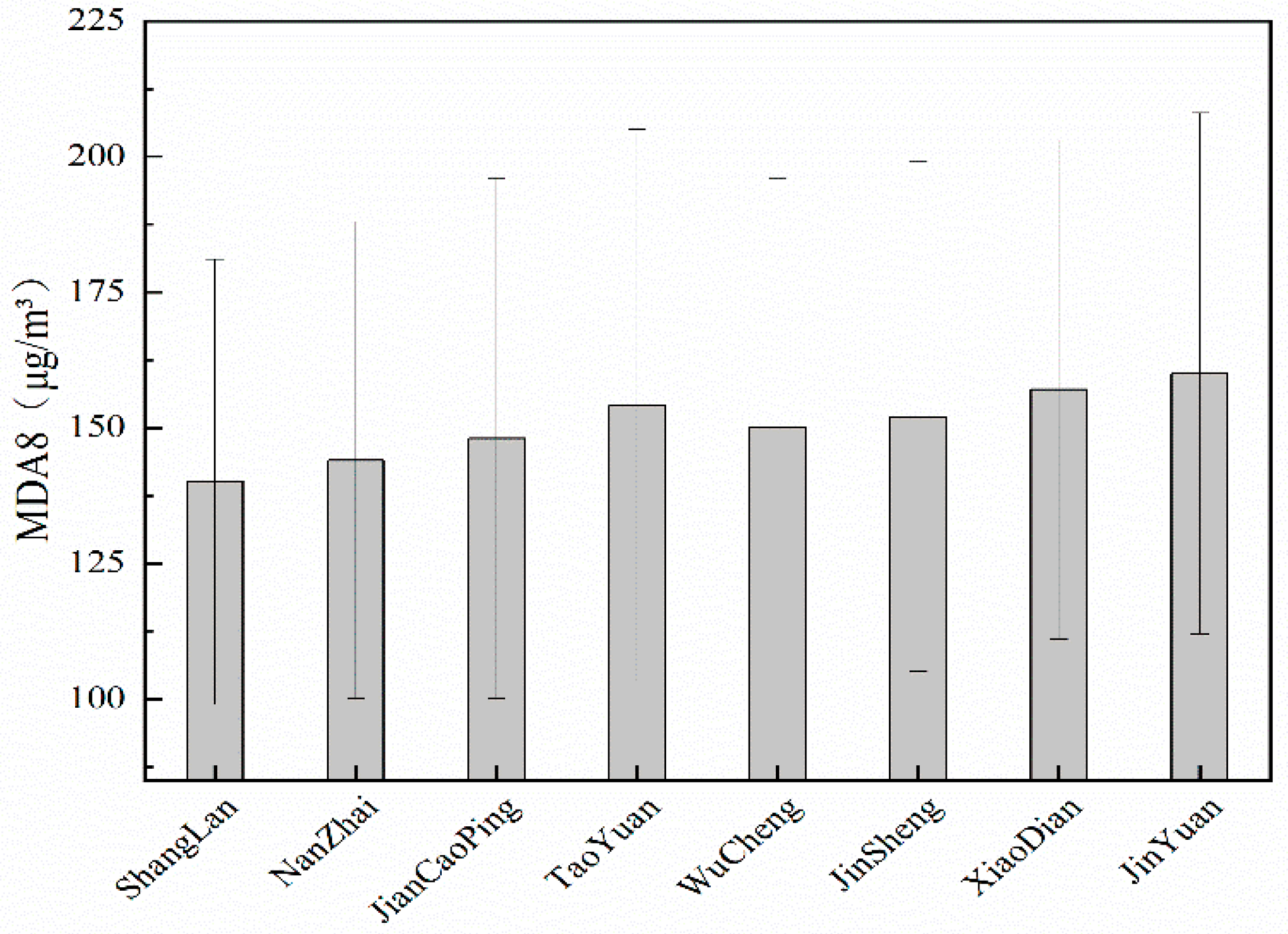

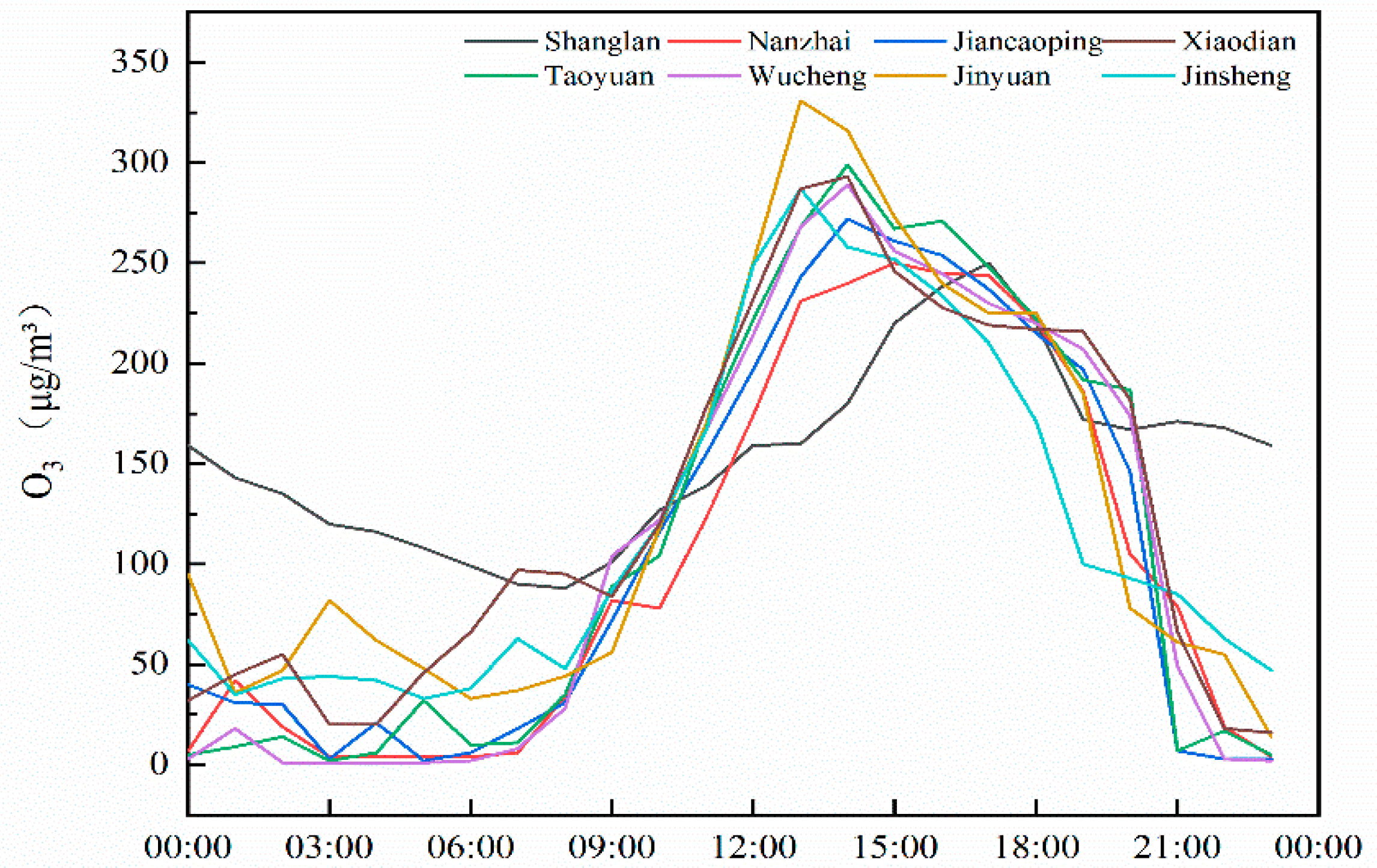
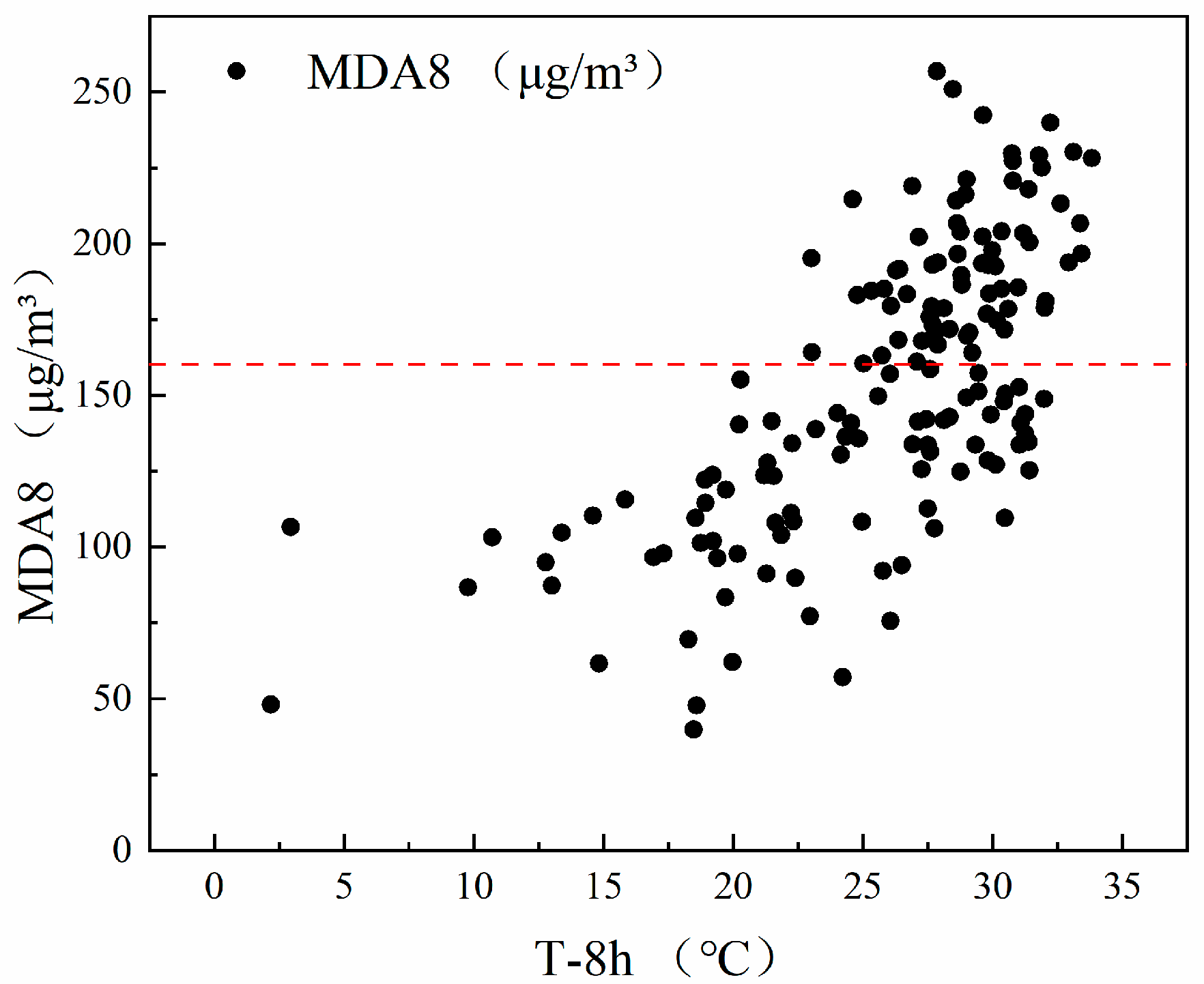
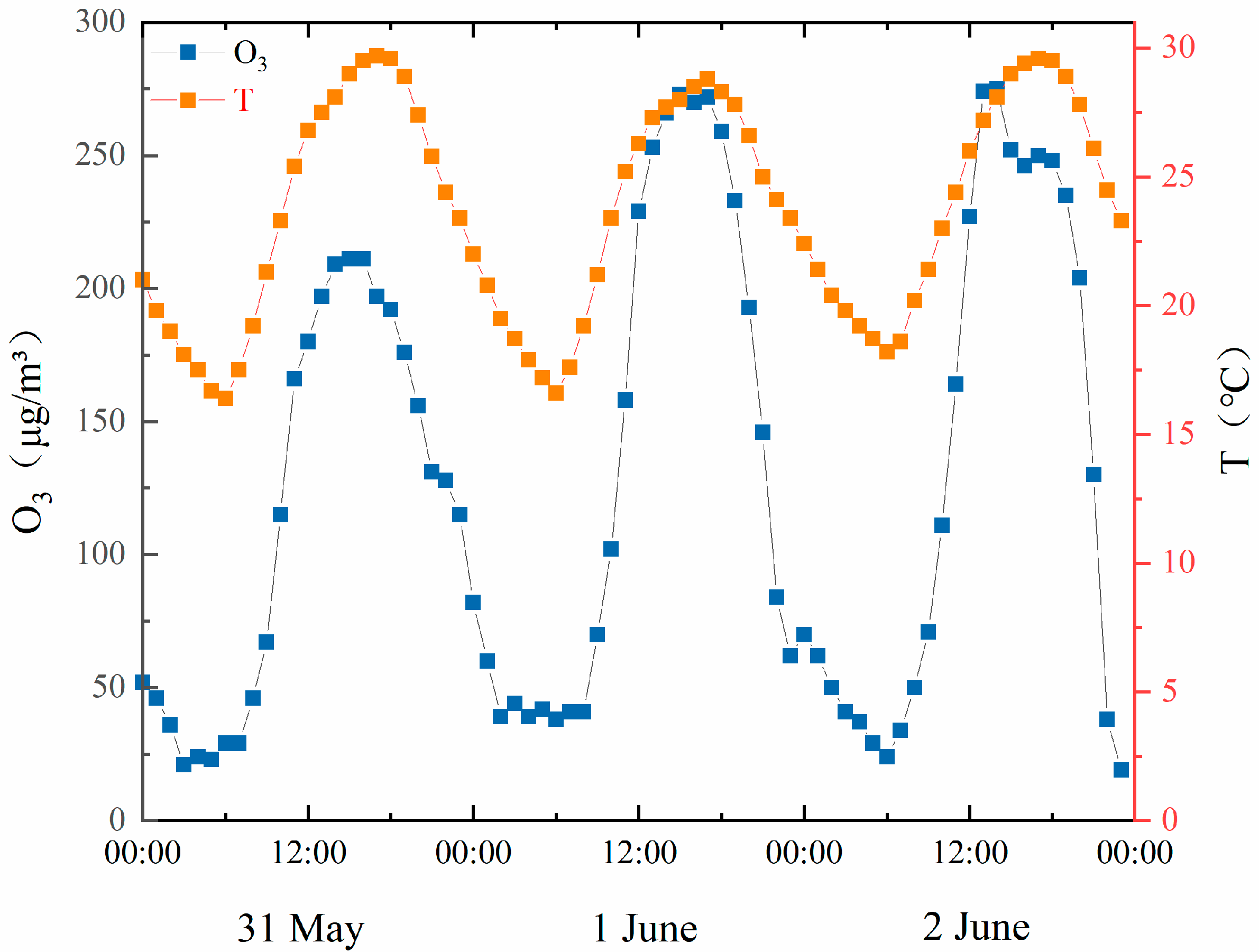
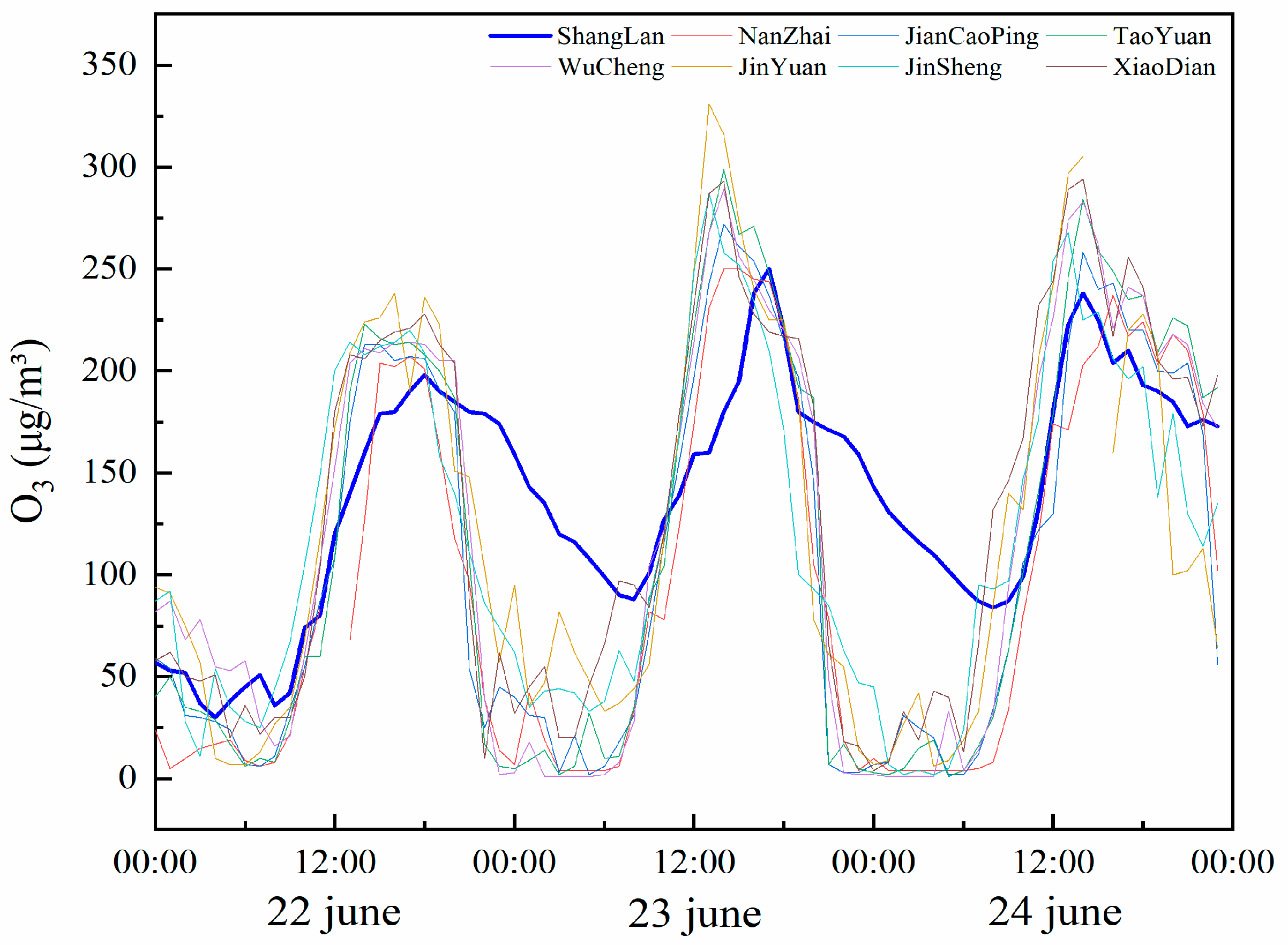



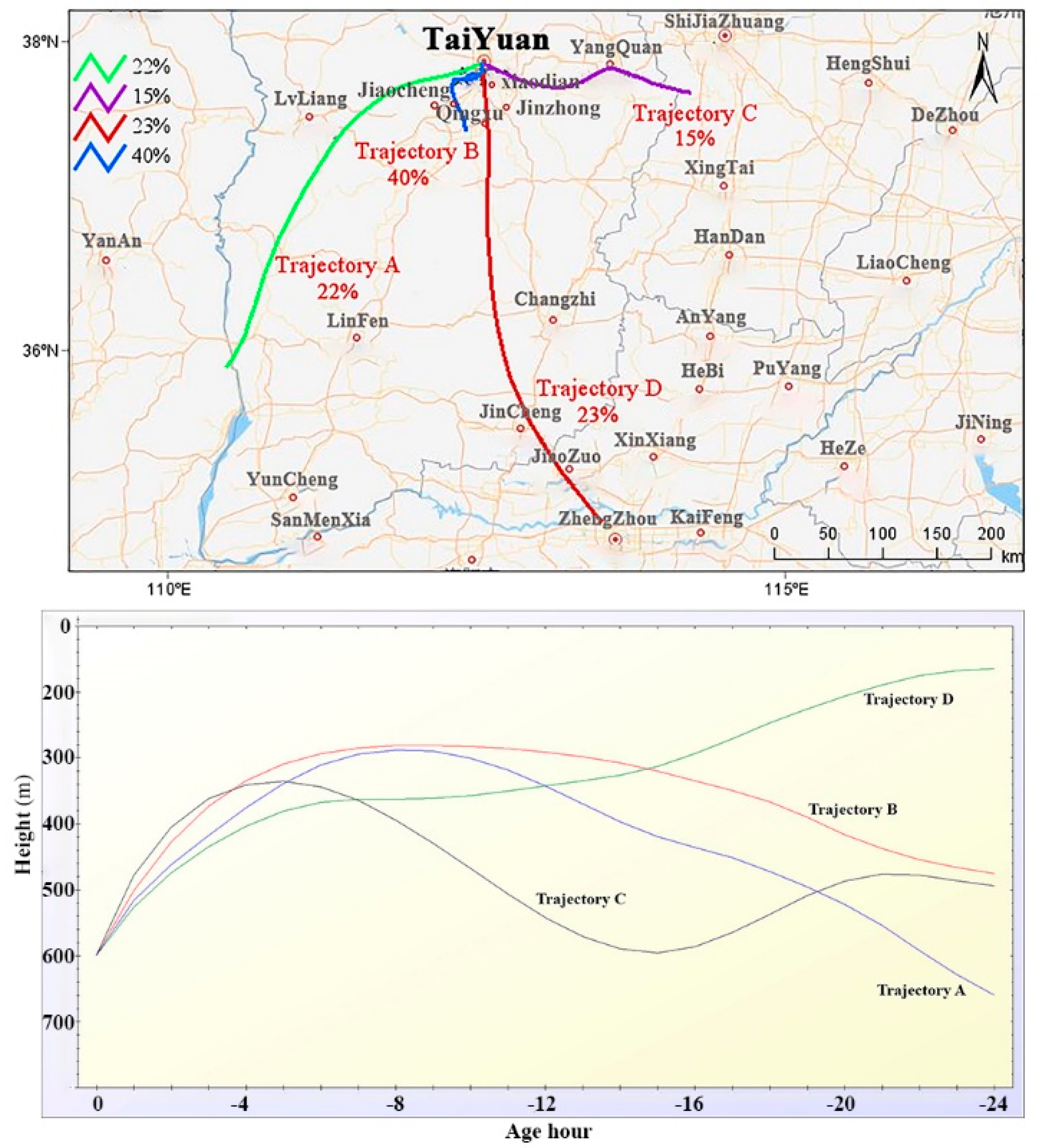
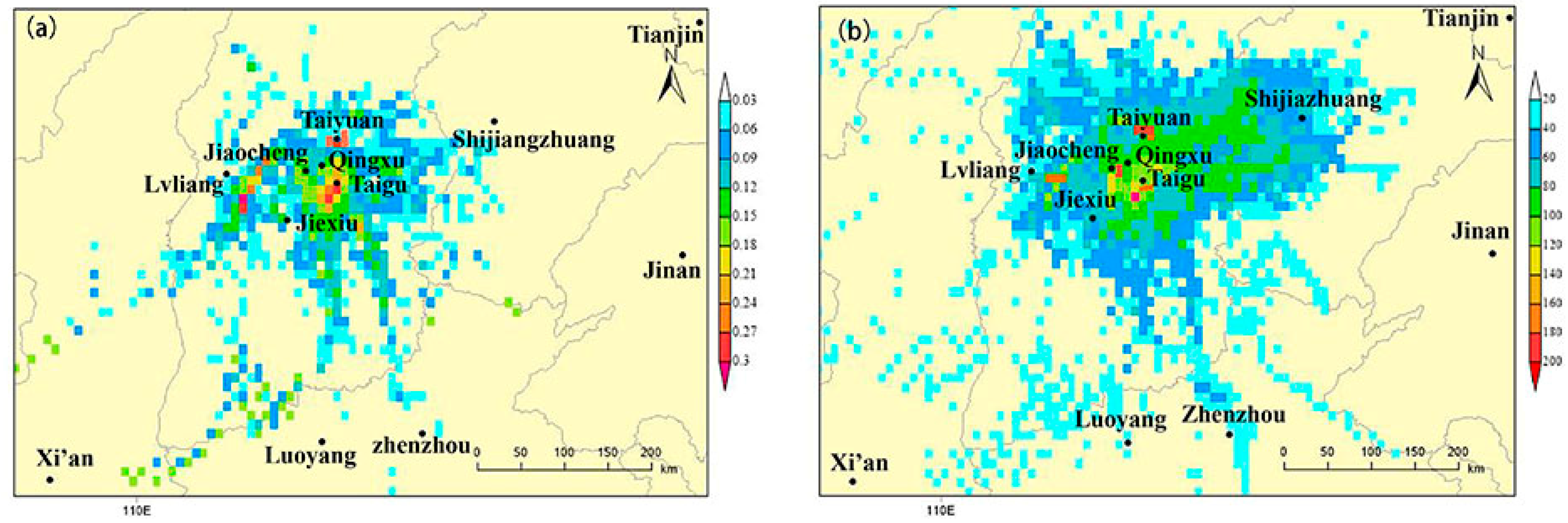
| Month | Jan. | Feb. | Mar. | Apr. | May | Jun. | Jul. | Aug. | Sep. | Oct. | Nov. | Dec. |
|---|---|---|---|---|---|---|---|---|---|---|---|---|
| The number of days MDA8 exceeded standard | 0 | 0 | 1 | 9 | 14 | 20 | 16 | 11 | 1 | 0 | 0 | 0 |
© 2020 by the authors. Licensee MDPI, Basel, Switzerland. This article is an open access article distributed under the terms and conditions of the Creative Commons Attribution (CC BY) license (http://creativecommons.org/licenses/by/4.0/).
Share and Cite
Li, B.; Zhou, Z.; Xue, Z.; Wei, P.; Ren, Y.; Cao, L.; Feng, X.; Yao, Q.; Ma, J.; Xu, P.; et al. Study on the Pollution Characteristics and Sources of Ozone in Typical Loess Plateau City. Atmosphere 2020, 11, 555. https://doi.org/10.3390/atmos11060555
Li B, Zhou Z, Xue Z, Wei P, Ren Y, Cao L, Feng X, Yao Q, Ma J, Xu P, et al. Study on the Pollution Characteristics and Sources of Ozone in Typical Loess Plateau City. Atmosphere. 2020; 11(6):555. https://doi.org/10.3390/atmos11060555
Chicago/Turabian StyleLi, Bin, Zhuangzhi Zhou, Zhigang Xue, Peng Wei, Yanjun Ren, Liyuan Cao, Xinyu Feng, Qingchen Yao, Jinghua Ma, Peng Xu, and et al. 2020. "Study on the Pollution Characteristics and Sources of Ozone in Typical Loess Plateau City" Atmosphere 11, no. 6: 555. https://doi.org/10.3390/atmos11060555




